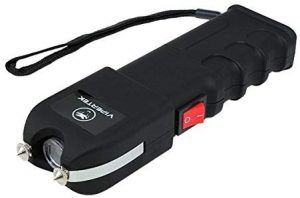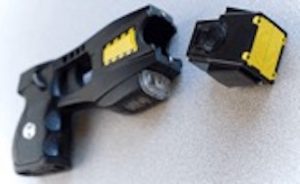If there are no paragraph separations in this article, please double-click on the title to create a more readable version.
TASER devices and stun guns each have slightly different functions, but the common purpose is to shock the aggressor and allow time to move strategically for improved control over the situation, without using lethal force. A TASER can be shot from a distance, and a stun gun requires direct contact with the attacker.

This stun gun has sharp points which might pierce clothing and will even set off an electric charge if somebody tries to grab it.
Other stun guns resemble cellphones, while another type looks just like a mag light. Neither has great power, so in order to get close enough to use it effectively, an attacker may be able to get the upper hand against an untrained civilian. Some stun guns are in the shape and length of a baton (12-19 inches) allowing the user to be a step or two away, rather than just at arm’s length.
In many states, law enforcement groups have been using stun guns to subdue targets for years. Pepper spray occasionally blows back at the user, so private citizens sometimes opt for using a stun gun as a self-defense tool.
Designed in the 1960s for use in tight spaces (inside airplanes) when firing a gun would be especially dangerous, a Taser is considered a safer (non-lethal) alternative to a handgun if used correctly. Concerned about a rise in gun-related injuries during arrests or captures, some law enforcement jurisdictions around the country have required that Tasers and/or stun guns be added to their officers’ equipment belts, giving the officer a choice in tense or escalating situations.

How does a Taser work? The cartridge contains 15-20 foot wires with probes attached at the end. The wires shoot out when the weapon is used. When the probes reach the target, they deliver a shock as well as pain, but this will only happen if both probes insert into the person’s body. In general, the person loses muscle control when hit with the probes, making an arrest easier or allowing the officer to stop an ongoing attack.
There are a variety of Tasers on the market, some of which guarantee contact even through clothing. Some recent Taser models also include the stun gun feature so that the prongs don’t have to be fired during every use.
One criticism of some Tasers is that they can misfire, causing real problems for the officer during an attack. The LATimes ran an article about the issue, comparing effective use in successive years:
Less critical, but potentially disturbing to a civilian Taser owner, is that storage in the home might become an issue. A curious friend or neighbor happening upon the Taser might fire it ‘just to see what it does.’ If it happens to misfire accidentally, somebody could get hurt. Burn marks on floors and ceilings from mis-firing have been reported by Kerrian followers, even when the Tasers have been handled properly. (True story)
Expense is a factor. Stun guns usually cost between $10 and $30. TASER devices have a lot more power and are a lot pricier because of that – running anywhere between $450 to $1,100. If the department in a town of 100,00 people has 180 officers working in the field and the units cost a minimum of $450 each – do the math. That’s an initial hit to the city budget of $81,000 and that’s before the replacement cartridges, etc. Each time the Taser is fired, it needs to be recharged and in some cases, a new cartridge must be inserted – at a cost of between $25 to $35 each.
Need to replace the Kevlar vests this year (a necessity every five years) or get that new million dollar fire truck the city needs so badly? Even if the Taser (or stun gun) is a great idea, the budget may not be able to handle it. So, if your town’s officers would like to have that option available to them, grants and donations from local law enforcement supporters may need to be sought out.
Legality
As of 2018, four states required background checks for Taser ownership.
- Illinois
- Maryland
- Massachusetts
- Minnesota
Two (2) states where Tasers and stun guns are completely banned for use for anyone other than law enforcement:
- Hawaii
- Rhode Island
But, most states do not regulate the purchase of Tasers or stun guns. That means no training requirements, background checks, or paperwork. Anyone in those states can buy and use them for self-defense. In many states, it is illegal to carry a concealed stun gun outside of your own home, and specifically illegal to carry it on school property. In some jurisdictions, stun guns are considered dangerous or deadly weapons, and as such, fall under those laws. Deadly weapons are generally banned from:
- parades
- funerals
- public demonstrations
- government buildings
It’s important to note about ownership of either a stun gun or a Taser or a combo of the two:
If someone falls and suffers a heart attack or other injury during the commission of a crime after being shocked with a stun gun or Taser, there are serious consequences. Instead of seeing its non-lethal purpose, the court may conclude that the tragic result came from the use, not the intent. i.e. the person might not have had the heart attack if not for being Tasered. If that happens, we now have a deadly weapon, and the legal concerns change under the law.
*Photos from Amazon

Tasers are too dangerous. The heart attack has occurred more than once. I prefer talking out differences with a round table. a la Robin Hood.
If there is time to cool the situation down, talking it out is always a better choice. Sadly, police on patrol faced with a dangerous situation, rarely have that option.